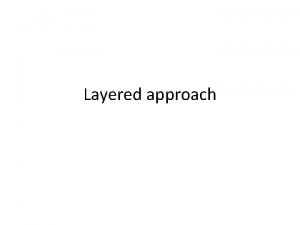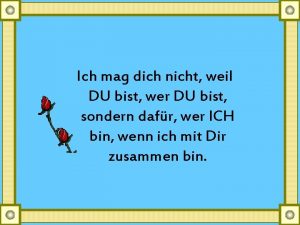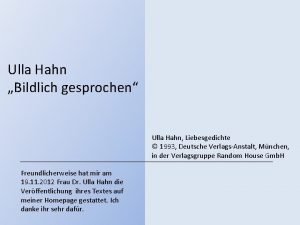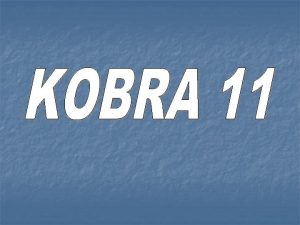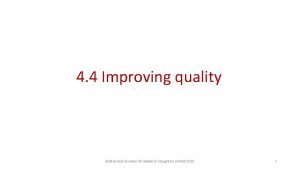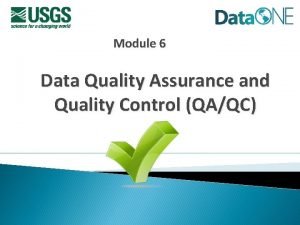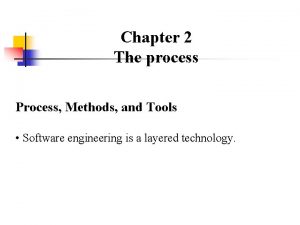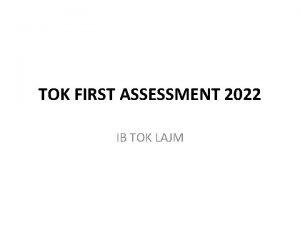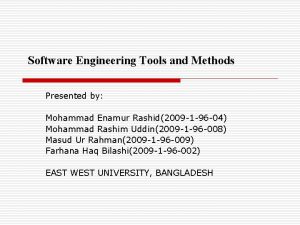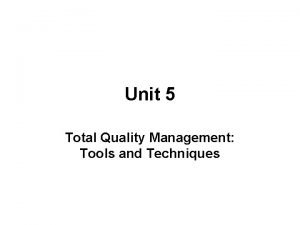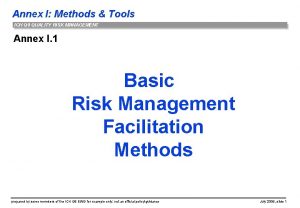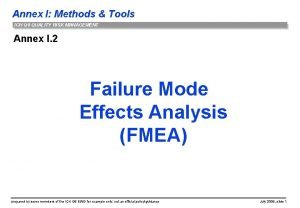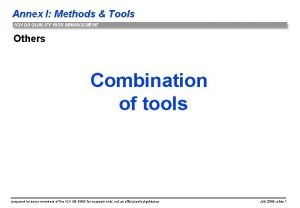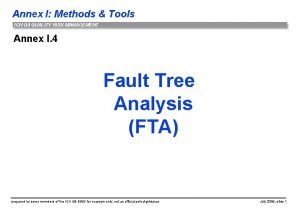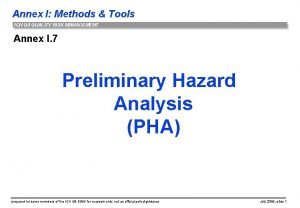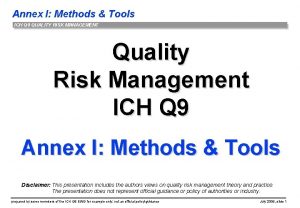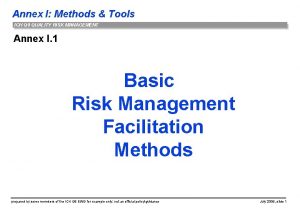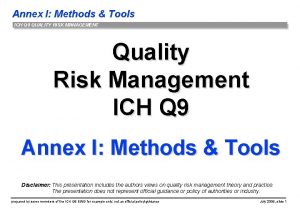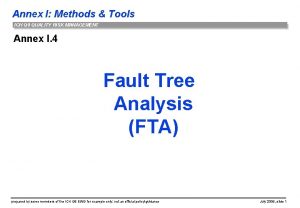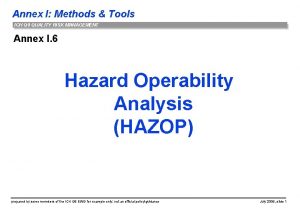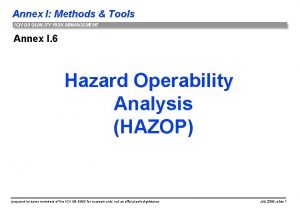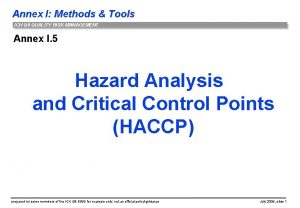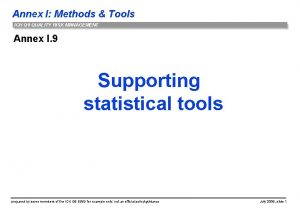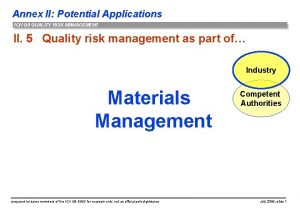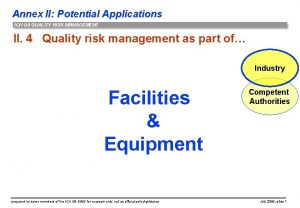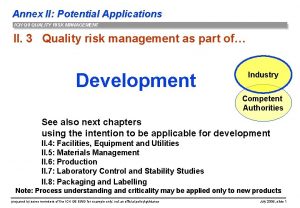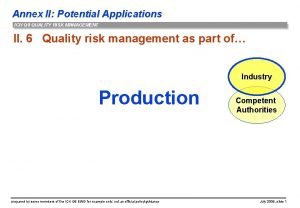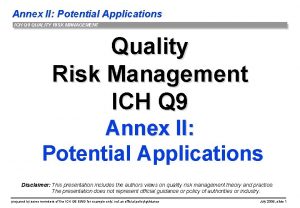Annex I Methods Tools ICH Q 9 QUALITY






















- Slides: 22

Annex I: Methods & Tools ICH Q 9 QUALITY RISK MANAGEMENT Annex I. 9 Supporting statistical tools prepared by some members of the ICH Q 9 EWG for example only; not an official policy/guidance July 2006, slide 1

Annex I: Methods & Tools ICH Q 9 QUALITY RISK MANAGEMENT I. 9: Supporting statistical tools · Control Charts (for example): > Shewhart Control Charts (see ISO 8258) > Control Charts with Arithmetic Average and Warning Limits (see ISO 7873) > Acceptance Control Charts (see ISO 7966) > Cumulative Sum Charts (ISO 7871) > Weighted Moving Average · Design of Experiments (DOE) · Pareto Charts · Process Capability Analysis ICH Q 9 prepared by some members of the ICH Q 9 EWG for example only; not an official policy/guidance Aid for: - Effective data assessment - Aid in determining the significance of the data set(s) July 2006, slide 2

Annex I: Methods & Tools ICH Q 9 QUALITY RISK MANAGEMENT I. 9: Supporting statistical tools Control charts (ISO 7870) · Indicates the range of variability that is built into a system · Shows statistically determined upper and lower control limits drawn on either side of the process average · The bounds of the control chart are marked by upper and lower control limits > Calculated by applying statistical formulas to data > Data points that fall outside these bounds represent variations due to special causes > Can be found and eliminated · Improvements require changes in the process prepared by some members of the ICH Q 9 EWG for example only; not an official policy/guidance ICH Q 9 July 2006, slide 3

Annex I: Methods & Tools ICH Q 9 QUALITY RISK MANAGEMENT I. 9: Supporting statistical tools Control charts Potential Areas of Use(s) · Monitoring critical parameters · Provides information to determine > Process capability > Variability > Control · Some charts are dealing with warning limits or trend analysis Example ICH Q 9 prepared by some members of the ICH Q 9 EWG for example only; not an official policy/guidance July 2006, slide 4

Annex I: Methods & Tools ICH Q 9 QUALITY RISK MANAGEMENT I. 9: Supporting statistical tools Control Chart: Shewhart Control Charts (ISO 8258) · Use warning limits · Analysis trend patterns Example Potential Areas of Use(s) · Statistical control of the process ICH Q 9 prepared by some members of the ICH Q 9 EWG for example only; not an official policy/guidance July 2006, slide 5

Annex I: Methods & Tools ICH Q 9 QUALITY RISK MANAGEMENT I. 9: Supporting statistical tools Control Charts with Arithmetic Average and Warning Limits (ISO 7873) · A control chart with warning and action limits Potential Areas of Use(s) · Enable a base period of quality measure · Provide a basis for the construction of relationships between a process and product quality · Producing recommendations for the adjustment of the process · Can be applied with process Analytical technology tools prepared by some members of the ICH Q 9 EWG for example only; not an official policy/guidance ICH Q 9 July 2006, slide 6

Annex I: Methods & Tools ICH Q 9 QUALITY RISK MANAGEMENT I. 9: Supporting statistical tools Control Chart: Acceptance Control Charts (ISO 7966) · Chart with a central line within an acceptable process zone · Ideal the average should be the target value Potential Areas of Use(s) · During regular batch manufacturing can give guidance for determine sample size, action limits and decision criteria · Ongoing improvements under process robustness/six sigma program can be initiated prepared by some members of the ICH Q 9 EWG for example only; not an official policy/guidance ICH Q 9 July 2006, slide 7

Annex I: Methods & Tools ICH Q 9 QUALITY RISK MANAGEMENT EXAMPLE Compilation of limits and ranges S. Rönninger, Roche prepared by some members of the ICH Q 9 EWG for example only; not an official policy/guidance July 2006, slide 8

Annex I: Methods & Tools ICH Q 9 QUALITY RISK MANAGEMENT I. 9: Supporting statistical tools Control Charts: Cumulative Sum Charts (ISO 7871) · Sum of deviations from the mean or predefined value and plot against time or number of occurrences (e. g. V-mask) · Determines if a monitored process is changing · They will detect shifts of. 5 sigma to 2 sigma in about half the time of Shewhart charts with the sample size prepared by some members of the ICH Q 9 EWG for example only; not an official policy/guidance July 2006, slide 9

Annex I: Methods & Tools ICH Q 9 QUALITY RISK MANAGEMENT I. 9: Supporting statistical tools Control Charts: Cumulative Sum Charts (ISO 7871) Potential Areas of Use(s) · Analyze process parameters or analytical results (e. g. PAT) · Allow the detection of slight discrepancies in a process before a trend is visible using other control charts Example ICH Q 9 prepared by some members of the ICH Q 9 EWG for example only; not an official policy/guidance July 2006, slide 10

Annex I: Methods & Tools ICH Q 9 QUALITY RISK MANAGEMENT EXAMPLE I. 9: Supporting statistical tools Assay Control Charts: Cumulative Sum Charts (ISO 7871) prepared by some members of the ICH Q 9 EWG for example only; not an official policy/guidance July 2006, slide 11

Annex I: Methods & Tools ICH Q 9 QUALITY RISK MANAGEMENT I. 9: Supporting statistical tools Control Chart: Weighted Moving Average · A simple, or arithmetic, moving average is calculated by adding the closing results of the security for a number of time periods and then dividing this total by the number of time periods Potential Areas of Use(s) · Analyze process parameters or analytical results (e. g. PAT) · Allow the detection of slight discrepancies in a process before a trend is visible using other control charts prepared by some members of the ICH Q 9 EWG for example only; not an official policy/guidance ICH Q 9 July 2006, slide 12

Annex I: Methods & Tools ICH Q 9 QUALITY RISK MANAGEMENT I. 9: Supporting statistical tools Design of Experiments (Do. E) · Design experiments based on statistical considerations · Analyze data and results to determine > establish key parameters > process variables > explore potential interactions prepared by some members of the ICH Q 9 EWG for example only; not an official policy/guidance July 2006, slide 13

Annex I: Methods & Tools ICH Q 9 QUALITY RISK MANAGEMENT I. 9: Supporting statistical tools Design of Experiments (DOE) Potential Areas of Use(s) · Research and development area · Retrospective evaluation of established parameters (Proven Acceptable Ranges · Systematically choosing certain combinations of variables it is possible to separate their individual effects · A special variant: focus on optimizing design parameters to minimize variation BEFORE optimizing design to hit mean target values for output parameters ICH Q 9 prepared by some members of the ICH Q 9 EWG for example only; not an official policy/guidance July 2006, slide 14

Annex I: Methods & Tools ICH Q 9 QUALITY RISK MANAGEMENT EXAMPLE I. 9: Supporting statistical tools Design of Experiments (DOE) in a submission · Type of experimental design used e. g. full/ fractional factorial · Justification of the selection of factors and responses · As an appendix > Number and levels of factors under study > The experimental matrix with the values of the responses for each combination of factors · Graphical representation > Coefficient plot of the relative significance of the factors under study and interactions between them Reflection paper on…PAT: EMEA/INS/277260/2005, March 20, 2006 prepared by some members of the ICH Q 9 EWG for example only; not an official policy/guidance July 2006, slide 15

Annex I: Methods & Tools ICH Q 9 QUALITY RISK MANAGEMENT EXAMPLE I. 9: Supporting statistical tools Design of Experiments (DOE) in a submission · Statistical evaluation of the model derived from Do. E (e. g. ANOVA table) · Graphical representation of the relationship of the significant factors under study with the responses (e. g. response surface and contour plots) providing a clear overview of the conclusions. · The Design Space (based on real test results and/or on the model) as defined in ICH Q 8 should be described · Verification of the model derived from Do. E Reflection paper on…PAT: EMEA/INS/277260/2005, March 20, 2006 prepared by some members of the ICH Q 9 EWG for example only; not an official policy/guidance July 2006, slide 16

Annex I: Methods & Tools ICH Q 9 QUALITY RISK MANAGEMENT I. 9: Supporting statistical tools Pareto Charts · Created by plotting the cumulative frequencies of the relative frequency data in descending order · The most essential factors for the analysis are graphically apparent, and in an orderly format Potential Areas of Use(s) · Identify those factors that have the greatest cumulative effect on a system · Few important factors in a process: Screen out the less significant factors prepared by some members of the ICH Q 9 EWG for example only; not an official policy/guidance ICH Q 9 July 2006, slide 17

Annex I: Methods & Tools ICH Q 9 QUALITY RISK MANAGEMENT EXAMPLE I. 9: Supporting statistical tools · Pareto Chart prepared by some members of the ICH Q 9 EWG for example only; not an official policy/guidance July 2006, slide 18

Annex I: Methods & Tools ICH Q 9 QUALITY RISK MANAGEMENT I. 9: Supporting statistical tools Process Capability Analysis · Estimate the potential percent of defective product prepared by some members of the ICH Q 9 EWG for example only; not an official policy/guidance July 2006, slide 19

Annex I: Methods & Tools ICH Q 9 QUALITY RISK MANAGEMENT I. 9: Supporting statistical tools Process Capability Analysis Potential Areas of Use(s) · Monitor / measure process variability · Analyze data retrospectively > Annual Product Review · Determine the relationship between process variability and specification · Requirement: Process specific data · Tool for both regulator and industry ICH Q 9 prepared by some members of the ICH Q 9 EWG for example only; not an official policy/guidance July 2006, slide 20

Annex I: Methods & Tools ICH Q 9 QUALITY RISK MANAGEMENT I. 9: Supporting statistical tools Histogram · A simple, graphical view of accumulated data > including its dispersion and central tendency · Provide the easiest way to evaluate the distribution of data Process compatibility Example ICH Q 9 prepared by some members of the ICH Q 9 EWG for example only; not an official policy/guidance July 2006, slide 21

Annex I: Methods & Tools ICH Q 9 QUALITY RISK MANAGEMENT I. 9: Supporting statistical tools Scatter diagrams (x/y-diagram) · To depict the influence that one variable has on another · Usually displays points representing the observed value of one variable corresponding to the value of another variable · How to perform: plot two parameters x and y in a two dimensional way ICH Q 9 http: //www. sytsma. com/tqmtools/Scat. html prepared by some members of the ICH Q 9 EWG for example only; not an official policy/guidance July 2006, slide 22
 Börse
Börse Quality focus in software engineering
Quality focus in software engineering Weil du einfach du bist
Weil du einfach du bist Gedicht bildlich gesprochen
Gedicht bildlich gesprochen Kobra 11 ich revirom je dialnica
Kobra 11 ich revirom je dialnica Ich habe keine wespentaille ich habe eine hummelhüfte
Ich habe keine wespentaille ich habe eine hummelhüfte Direct wax pattern
Direct wax pattern Benefits and difficulties of improving quality
Benefits and difficulties of improving quality Quality control methods for medicinal plant materials
Quality control methods for medicinal plant materials Qc definition
Qc definition Process methods and tools in software engineering
Process methods and tools in software engineering Tok prompts 2022
Tok prompts 2022 Software engineering tools and methods
Software engineering tools and methods Quality assurance vs quality control
Quality assurance vs quality control Quality management pmp
Quality management pmp Quality metrics pmp
Quality metrics pmp Total quality management seminar
Total quality management seminar Quality improvement vs quality assurance
Quality improvement vs quality assurance Quality assurance concepts
Quality assurance concepts Quality gurus of tqm
Quality gurus of tqm Quality is free: the art of making quality certain
Quality is free: the art of making quality certain What is tqm
What is tqm Interrelationship diagram
Interrelationship diagram

